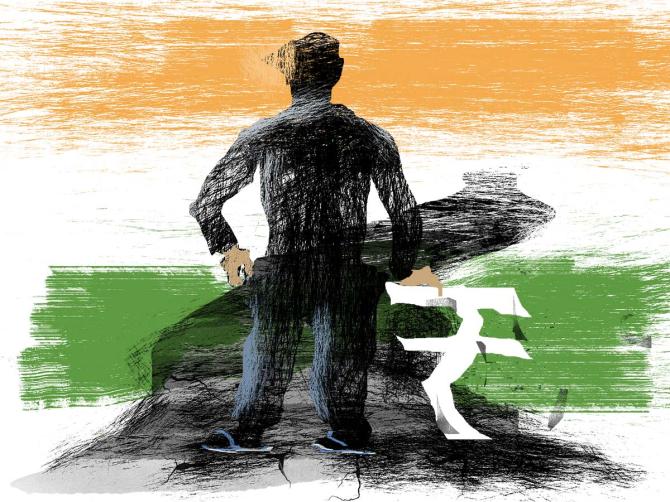 | « Back to article | Print this article |
Risk aversion is currently a dominant depressant to economic recovery, points out Shankar Acharya, former chief economic advisor to the Government of India.

A few days ago, the National Statistical Office released its estimate of GDP decline in Q1 at 24 per cent.
Furthermore, since such quarterly estimates mostly fail to capture developments in the informal/unorganised, non-agricultural sector, this estimate of decline is likely to be revised upwards eventually, given what is known about the devastation to this sector caused by the lockdown.
So, realistically, the Q1 decline in GDP is likely to have been even greater, in the order of 30 per cent.
Even 24 per cent is a massive loss of output and incomes and greater than any suffered by other G-20 countries.
As the government's chief economic adviser has pointed out, this was probably because India's lockdown in the first two months was the strictest.
Whether the health benefits gained were commensurate is a separate issue, on which credible answers will only emerge later.
Quite naturally, the focus has now shifted to recovery from this devastating economic trough. The CEA expects a V-shaped recovery. The first, brutal downward stroke of the V has certainly occurred.
I fear the upward stroke may be far from linear.
In y-o-y growth numbers, Q2 would range between (-) 10 to (-) 12 per cent, Q3 between (-) 5 and (-)7 per cent, and Q4 between (-) 4 and (-) 5 per cent.
What's more, the level of India's quarterly GDP in Q4 would likely remain below the average quarterly level of 2019-2020 in the first two or three quarters of 2021-2022.
Now, in the light of all that has happened in last few months, these expectations of May and June still look fairly reasonable to me, perhaps even a little optimistic.
This means that full year real GDP in 2021-2022 would still remain below the level of 2019-2020. That is certainly not a V-shaped recovery.
There are several reason why economic recovery is likely to be slow and halting.
First, we have to understand that the immense blow to the economy has come from the supply side because of the central government policy of strict lockdown.
Even after it has been progressively lifted from June, fresh, partial lockdowns have been repeatedly imposed by state governments re-disrupting supply chains.
Thus, the trajectory of economic output so far, and probably for the rest of the year, is being determined more by evolving supply constraints than demand factors.
In this context, the chorus of voices calling for large fiscal stimuli is mostly misdirected.
Fiscal relief to the poor and the worst hit was and remains a priority.
A fair amount has been done by the government within the limitations of its weak delivery systems and dire fiscal situation.
Second, the initial harsh lockdown knocked the stuffing out of the already weak fiscal health of both central and state governments as revenues collapsed across the board.
Absent the Covid pandemic, the combined deficit of the Centre and states, properly accounted, would probably have been about 8 per cent of GDP (with the Centre accounting for 5 per cent) in 2020-2021.
After the Covid-lockdown shock, this could well jump to unprecedented levels of 13 to 15 per cent of GDP.
That means a rise in the government debt/GDP ratio at year-end to dangerously high levels of 85 to 90 per cent.
The very high future interest burdens and borrowing requirements will pose a serious drag on future economic growth and stoke inflation.
So, my assessment would be that to the extent a fiscal stimulus has a positive role in a largely supply constrained economy, there is plenty of it already being pumped in, perhaps even too much.
Third, risk aversion is currently a dominant depressant to economic recovery in various ways. For enterprises, risk-mitigating precautions (often mandated ones) pose additional costs, reducing supply response.
In spite of them, risk-aversion by workers remains a dampener, especially against a background of a rampaging pandemic.
Furthermore, supply is being weakened as many small and medium enterprises cease to function after months of struggling to stay afloat.
Consumers, especially older, richer ones, are naturally avoiding consumption transactions involving close contact.
Amazon and Flipkart cannot substitute for barber shops, airline and train trips, restaurants, hotels, tourism and many other items of India's very large service economy.
Fourth, the long-stressed financial intermediation sector is under renewed pressure as its extant loans and advances look increasingly shaky.
Regulatory forbearance by the RBI and borrower-friendly court judgments threaten the viability of commercial banks and NBFCs and the possible safety of depositors' savings.
This naturally damps the flow of new loans and advances and may do so increasingly. More bail-outs of banks and NBFCs may loom.
But who will do the bail-outs and with resources from where?
Fifth, as the world economy recovers, and with it world trade, there are opportunities for seeking dynamism from external markets, especially in resilient and fast recovering East and Southeast Asia.
But to benefit from such opportunities, we would need to reverse our three-year old lurch towards protectionism and join the Regional Comprehensive Economic Partnership.
How likely is that?
Shankar Acharya is honorary professor at ICRIER and former chief economic adviser to the Government of India. Views are personal.